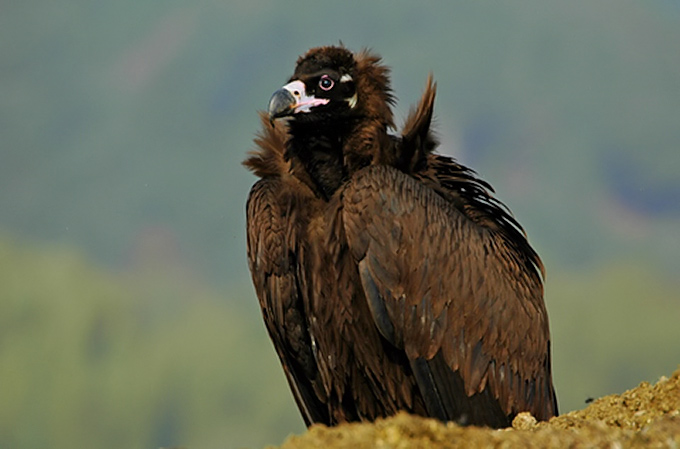Cinereous vulture: Red Data Book of Armenia

Hawks and eagles — Accipitridae
Status. A rare species of significantly decreasing population. Listed in the IUCN Red List of Threatened Species (ver. 3.1) as Near Threatened NT. According to IUCN criteria categorized as Endangered EN D.
Distribution. Distributed in Southern Europe, Caucasus, Middle East and Central Asia.
Distribution in Armenia. Recorded in different parts of Armenia. Aeries are known on the Geghama and Vardenis ridges within the Abovian, Ararat, Artashat, Vayk and Eghegnadzor districts. Belongs to non–migratory and nesting species of Armenia.
Habitats. Mountain grasslands alternated with arid juniper sparse forests on downhills at 1200–2000 m above sea level. The nesting sites are significantly destroyed because of their intensive use for grazing.
Biological traits. The aerie is usually placed on tree top, seldom on cliffs or ground, among the stones. Eggs are laid usually from late February to late April. Clutches found so far in Armenia contained only one egg brooded by both parents for 55 days. According to some findings, cinereous vultures can lay also two eggs. Hatchlings emerge in late April, or in early June as the latest. Flying juveniles can be recorded from late July to late September.
Population size and its trends. Possibly, does not exceed 50 nesting pairs.
Major threats. Possibly, reduction of prey base ensuing from the decline of wild ungulate populations, as well as poaching and snaring.
Conservation measures. Protected in Khosrov Forest Reserve where this species regularly breeds. It is essential to identify suitable nesting sites and to strinctly protect them throughout the range, particularly in Khosrov Forest Reserve.
Suggestions
 The Ministry of Environment sent a letter international partners to draw their attention to the real danger of environmental disasters as a result of Azerbaijan's large-scale aggression towards the territory of Armenia
The Ministry of Environment sent a letter international partners to draw their attention to the real danger of environmental disasters as a result of Azerbaijan's large-scale aggression towards the territory of Armenia
 Vicia pisiformis: Red Data Book of Armenia
Vicia pisiformis: Red Data Book of Armenia
 Vavilovia formosa: Red Data Book of Armenia
Vavilovia formosa: Red Data Book of Armenia
 Trigonella capitata: Red Data Book of Armenia
Trigonella capitata: Red Data Book of Armenia
 Trigonella astroides: Red Data Book of Armenia
Trigonella astroides: Red Data Book of Armenia












